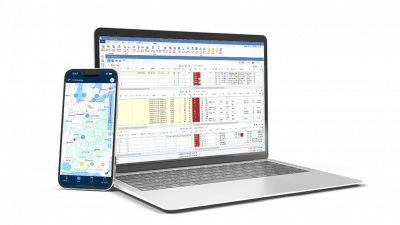In the trucking industry, the terms “productivity” and “efficiency” are often used interchangeably, but they’re distinct yet complementary concepts.
Productivity is output-focused — it’s about the quantity of completed loads or deliveries.
Efficiency refers to the quality of processes and activities that contribute to output.
This post looks at the relationship between productivity and efficiency, how to balance these two metrics, and how technology can boost productivity.
How Fleet Productivity and Efficiency Intersect
Productivity is a high-level metric that doesn’t provide a complete picture of fleet performance. You can be wildly productive without being efficient, and you can be 100% efficient but generate a lower output. Here’s an example:
- “Fleet Manager A” sets an ambitious goal: Boost revenue by $5,000 per month by shortening turnaround time to two days and increasing total deliveries by 10%. The fleet meets this goal — but only because workers hastily packed cargo. Several customers complain when their cargo arrives damaged, and they request a refund.
- “Fleet Manager B” sets a goal of reducing the number of loads to ensure all shipments arrive on time and undamaged. This fleet is less productive than Fleet A, in terms of total deliveries, but it’s more efficient, because all customers are satisfied, the cargo arrived safely, and there are no damage-related claims.
A final distinction on these two metrics is that you can produce less but be 100% productive, as illustrated in this comparison:
| Fleet A | Fleet B | |
| Number of deliveries | 20 | 15 |
| Revenue ($1K per delivery) | $20K | $15K |
| Rejected/damaged deliveries | 6 | 0 |
| Losses (refunds, hours, etc.) | $7.5K | 0 |
| Total revenue | $12.5K | $15K |
To get the most out of a fleet, it’s important to focus on both productivity and efficiency — not just completing loads, but also refining the processes that get you there. Of course, trial-and-error isn’t the best way to refine processes, which is why you need carrier fleet management technology.
How Transportation Management Systems (TMS) Improve Fleet Productivity
When you consider all of the components that can impact fleet efficiency — load optimization, dispatching, and regulatory compliance, for example — it’s easy to see why a TMS is the only way to manage a fleet.
Let’s take a look at how a TMS improves both efficiency and productivity.
Eliminates Task-Switching
One of the challenges fleet managers face is the need to switch between different systems and applications for various tasks — vehicle tracking, driver communication, maintenance scheduling, and more. Task-switching is inefficient, and using multiple disparate platforms and apps results in scattershot data.
A TMS offers deep integration capabilities, so you can access your preferred technology from within a single interface. That means you connect all of your data points for every load, including:
- Bills of lading
- Driver HOS logs
- Mileage
- Freight lanes
- Dispatcher-driver communication logs
- Delivery exceptions and delays
- Invoices
- Time cards
- Fuel costs
Simplifies Dispatching
A TMS eliminates the cumbersome and inefficient parts of dispatching, like tracking all jobs, routes, and drivers in a spreadsheet. Once you set up your TMS, it can automatically:
- Pair trucks with the most profitable loads
- Match freight offers with preferred lanes
- Track truck location and provide real-time ETAs
- Send rate confirmations, maps, instructions, and updates to drivers
The best TMS platforms for carriers offer a mobile app with communication features. With all communication happening inside the app, fleet managers and dispatchers get complete visibility into every job.
Optimizes Maintenance
A mechanical failure or emissions violation that takes a truck out of commission is a big drain on productivity. A TMS integrates with fleet telematics — a combination of sensors and software — that enhance maintenance and improve compliance.
With a TMS, you can automate service reminders, improve predictive maintenance, and keep compliance-ready service records for every truck in your fleet. And trucks that are in optimal condition have better fuel efficiency, which can significantly reduce fuel costs for fleets.
Drives Efficiency in Load Planning
Some TMS platforms include AI that helps optimize fleet utilization and load planning. With this functionality, you can reduce deadhead miles and make better strategic decisions.
Real-World Examples of Productivity Improvements
Let’s look at a few examples of how a TMS can translate into productivity gains for fleets:
Overcoming ‘Chaos’
A small carrier wanted to scale, but cited “organized chaos” as inhibiting growth. The company was losing track of payments, communicating via random methods, and struggling to predict capacity. These internal problems led to deteriorating client relationships that were threatening their viability.
The founder discovered a solution in PCS TMS for Carriers, which enabled the single-truck business to a fleet of 26 trucks.
Enabling Growth
An owner-operator in the oilfield sector was struggling with dispatcher-driver communication and tracking its deliveries. The company partnered with PCS TMS to improve its internal operations, and in four years, was able to open 22 terminals, with plans to continue expanding.
Increasing Revenue Per Mile
A carrier in the midst of scaling needed a way to improve invoicing and payment management. Another objective was boosting revenue per mile by reducing deadhead miles. The carrier chose PCS TMS to help them manage operations, replacing a spreadsheet-based accounting process and automating direct-billing. PCS TMS also helped the company reduce deadhead miles for maximum profitability.
Barriers to Productivity in the Trucking Industry
While the benefits of a TMS are clear, many fleet operators still face challenges in adopting these solutions. Common barriers include resistance to change, lack of training, and concerns about the cost of new systems. However, the long-term gains in productivity, reduced operational costs, and improved customer satisfaction far outweigh the costs of a TMS.
A TMS with a knowledge base helps users get up to speed with their new software. With short, easy-to-digest instructional videos, fleet managers can focus on the features they need in order of priority and start getting the benefits from a TMS as they learn more about it.
Discover Your Fleet’s Full Potential
Improving fleet productivity requires fleet managers to “pull the right levers,” but without actionable data, it’s difficult to know which actions will have the greatest impact. A TMS gathers and analyzes data to help fleet managers make the best decisions.
If outdated processes and disjointed technology are getting in the way of growth, it’s time to see what a TMS can do for you. Get in touch today to see how PCS TMS for Carriers works.



